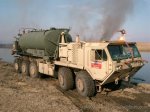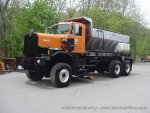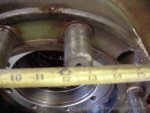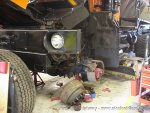-
Steel Soldiers now has a few new forums, read more about it at: New Munitions Forums!
Kenworth 8x8 XM1074 PLS
- Thread starter M1075
- Start date

More options
Who Replied?M1075
Active member
- 3,589
- 6
- 38
- Location
- Oklahoma City
No, I belive it is multilift, from UK.tcody said:M1075,
Is that a Palfinger hook loader? What model? Would love to see a few more pictures of it!
Thane
- 3,585
- 7
- 0
- Location
- Parkville, MD
The initial test trucks did use UK components on the hook loaders this was back when hook loading was in it's infancy or at least in it's youth you did not see slide on slide off dumpsters all over the place back then and they were just becoming the rage when the Army saw that Great Britan has worked with this concept for their Army.
- 8,518
- 2,698
- 113
- Location
- Monrovia, Ca.
Re: RE: Kenworth 8x8 XM1074 PLS
M1075, that is a great truck, I have always loved T800 KW's. Does it run? The exterior looks to be in awsome condition. How's the inside?
Depends on what year it was built. The XT engines were great. The older 444's were a bit on the un reliable side. If it is CPL 806 or an early 910, watch out. They eat cams, break lower follower shafts, bend and break injector push tubes, soot the oil heavily, smoke white and run rough on cold starts and wear bearings prematurely. There were some changes to the later 910 and 1210 CPL engines that fixed the issues that were common on the 806 engines, turning the lower follower shafts 90 degrees...they broke at the oil holes, 17 to 18 degree injector cups to stop the sooting and bearing wear..might be the other way around on the cups..CRS kickin' in, the addition of a viscosity sensor and a check valve in the oil side of the injector to eliminate the heavy white smoke and rough running at cold start. There was also a change in the overhead set procedure from the top stop type of set to a torque method.Angus1 said:I can tell you that the cummis 444 and 444XT were great motors. But Injectors were very expensive. And be sure to run the overhead every 100,000 miles. I like it and wish I could get my hands on one.
M1075, that is a great truck, I have always loved T800 KW's. Does it run? The exterior looks to be in awsome condition. How's the inside?
1ton
New member
- 95
- 0
- 0
- Location
- Lawrence, KS
RE: Re: RE: Kenworth 8x8 XM1074 PLS
Are the flat racks for the oshkosh and KW the same length? It's funny that the T800 would have roll over problems when the oshkosh has a much heavier cab and its engine way up in the air.
Are the flat racks for the oshkosh and KW the same length? It's funny that the T800 would have roll over problems when the oshkosh has a much heavier cab and its engine way up in the air.
- 3,585
- 7
- 0
- Location
- Parkville, MD
RE: Re: RE: Kenworth 8x8 XM1074 PLS
A big difference is the tires on the PLS are like the HEMTT. These trucks are souped up KW's that use tires that are closer to OTR tires. Also the PLS by Oshgosh was built as a PLS not a KW mated to a British lift system. All in all these are very heady trucks and I am glad to see this one in the Steel Soldier comunity
A big difference is the tires on the PLS are like the HEMTT. These trucks are souped up KW's that use tires that are closer to OTR tires. Also the PLS by Oshgosh was built as a PLS not a KW mated to a British lift system. All in all these are very heady trucks and I am glad to see this one in the Steel Soldier comunity
Angus1
New member
- 388
- 0
- 0
- Location
- Freeland,Pa
Re: RE: Kenworth 8x8 XM1074 PLS
Then I shall rephrase. I had a 444 and a 444xt in a pair of petes I owned, And only had injector issues with them.WillWagner said:Depends on what year it was built. The XT engines were great. The older 444's were a bit on the un reliable side. If it is CPL 806 or an early 910, watch out. They eat cams, break lower follower shafts, bend and break injector push tubes, soot the oil heavily, smoke white and run rough on cold starts and wear bearings prematurely. There were some changes to the later 910 and 1210 CPL engines that fixed the issues that were common on the 806 engines, turning the lower follower shafts 90 degrees...they broke at the oil holes, 17 to 18 degree injector cups to stop the sooting and bearing wear..might be the other way around on the cups..CRS kickin' in, the addition of a viscosity sensor and a check valve in the oil side of the injector to eliminate the heavy white smoke and rough running at cold start. There was also a change in the overhead set procedure from the top stop type of set to a torque method.Angus1 said:I can tell you that the cummis 444 and 444XT were great motors. But Injectors were very expensive. And be sure to run the overhead every 100,000 miles. I like it and wish I could get my hands on one.
M1075, that is a great truck, I have always loved T800 KW's. Does it run? The exterior looks to be in awsome condition. How's the inside?
M1075
Active member
- 3,589
- 6
- 38
- Location
- Oklahoma City
RE: Re: RE: Kenworth 8x8 XM1074 PLS
I haven't had much time to fool with it, but the truck runs great. I need to get some different wheels for it so I switch over to the more common 16R20 tire. The inside and out is fairly clean. The alternator needs to be repaired/replaced, the crane/winch has been disabled, and a hyrdaulic ram from the LHS has been removed. It will take some time and money to get everything working properly, but I do look forward to using the LHS from the cab and the crane with the included remote!
The flatracks have the same outer dimensions, as they are built to conform with NATO standard (STANAG 2413) and are basically 20' ISO size. I have noticed some difference in how the flatracks are secured to the trailer, but the truck seems common. The original KW flatracks have (did have) an inferior, wood deck on them.
As far as rolling, both the KW and Oshkosh trucks have been rolled. I'm not sure about the MAN. Anytime you carry a 15-20 ton payload that high off the ground, the COG will exceed all normal rules of thumb (i.e 85% of track width). Look at this picture. The green water module weighs about 36,000# full. Note that a 6' man can just about walk under it and you will get an idea of where the weight is.
I haven't had much time to fool with it, but the truck runs great. I need to get some different wheels for it so I switch over to the more common 16R20 tire. The inside and out is fairly clean. The alternator needs to be repaired/replaced, the crane/winch has been disabled, and a hyrdaulic ram from the LHS has been removed. It will take some time and money to get everything working properly, but I do look forward to using the LHS from the cab and the crane with the included remote!
The flatracks have the same outer dimensions, as they are built to conform with NATO standard (STANAG 2413) and are basically 20' ISO size. I have noticed some difference in how the flatracks are secured to the trailer, but the truck seems common. The original KW flatracks have (did have) an inferior, wood deck on them.
As far as rolling, both the KW and Oshkosh trucks have been rolled. I'm not sure about the MAN. Anytime you carry a 15-20 ton payload that high off the ground, the COG will exceed all normal rules of thumb (i.e 85% of track width). Look at this picture. The green water module weighs about 36,000# full. Note that a 6' man can just about walk under it and you will get an idea of where the weight is.
Attachments
-
62.1 KB Views: 619
wellesleyhighway
New member
- 32
- 1
- 0
- Location
- wellesley, massachusetts
Am posting this with a little hesitation...Found this site this AM and was originally searhing for parts/info manuals for the KW PLS. Figured I would attempt to attach this photo of our KW we purchased on a State Surplus program. As you can tell we took some interest on doing it right. The truck has been a great addition to our fleet of Municipal snow fighters. We are having some difficulty locating front end parts (i.e. wheel studs) for the Rockwells. The repair facility here also had wiring questions as to what is 24v versus 12v
Attachments
-
82.6 KB Views: 459
M1075
Active member
- 3,589
- 6
- 38
- Location
- Oklahoma City
That truck looks different than the other KWs I have seen. What is the year model of the truck? Got any pics from when you acquired it?
wellesleyhighway
New member
- 32
- 1
- 0
- Location
- wellesley, massachusetts
Went to get the disk out and its blank. We shortened the frame by about 4 feet. It was equipped with the UK made "Mutlilift", but had several solenoid issues and didn't retract half the time. The Platform was retro-fitted to fit another small roll-off truck we have.
Our first hurdle was a PTO for a central Hydraulic system. The one off the Allison Trans. couldn't work due to a RPM issue because with regular driving (over 1500 RPM) the PTO wouldn't last. We opted for a Belt driven Pump off the Cummins with an on/off switch.
As far as we were told by the Military Unit we got it from, and what Armyman30yearsplus, it was demo-ed by the army here in Mass. and was beaten out by OSHKOSH. We understand it to be a 1984 KW C-520 with a 400? Cummins, Allison trans, and Rockwell axles all around. Rides great, plows great, just the issues about wiring and replacement studs for front axles...Any ideas?
Our first hurdle was a PTO for a central Hydraulic system. The one off the Allison Trans. couldn't work due to a RPM issue because with regular driving (over 1500 RPM) the PTO wouldn't last. We opted for a Belt driven Pump off the Cummins with an on/off switch.
As far as we were told by the Military Unit we got it from, and what Armyman30yearsplus, it was demo-ed by the army here in Mass. and was beaten out by OSHKOSH. We understand it to be a 1984 KW C-520 with a 400? Cummins, Allison trans, and Rockwell axles all around. Rides great, plows great, just the issues about wiring and replacement studs for front axles...Any ideas?
M1075
Active member
- 3,589
- 6
- 38
- Location
- Oklahoma City
That is a bummer about the disk. I was really hoping for some pictures. I believe the Mulitlift is still used on the production PLS. Did you remove an axle? I am surprised by your model year as mine is a 1990 KW T800 with 444 Cummins and 9-speed Allison. If you give the VIN to your local KW dealer, they should be able to get you a build sheet on your truck. That should detail the 24v parts and the axle specs. What size are the lug nuts? 1.5"? 33mm?
wellesleyhighway
New member
- 32
- 1
- 0
- Location
- wellesley, massachusetts
My boss will try to work the disk and get what we can off it. I was wrong when I said 1984, The door plate gives a Man. date of Mar 86. Also the Motor is listed as NTC-400, tranny is HT7500DRD, and the GVW is 64,000. We didn't remove an axle, just dropped the shaft, unbolted the rears, slid them foward with the direction of a specialist. I think I saw a pic of your KW, like the crane. Attached are pix of the studs, they are about 1". The lugs are 1.5". As far as I was told the local KW dealer said those studs weren't available. I will check on the build sheet, don't know if that was asked? Thank you for all your input, were not scratching our heads too badly yet, just glad to find this site
Attachments
-
62.2 KB Views: 311
-
90.6 KB Views: 320
justsomeguy
New member
- 15
- 0
- 0
- Location
- Las Vegas
That C-500 might have been prototype, but the KW that was tested against the MAN and Oshkosh was a T-800. I might be wrong, as the last time I saw one was a few years ago, but I thought the T-800's have planatery diffs? Good looking truck non the less! I worked for KW for a few years and for the most part they only have cookie cutter schmatics, but deffinatly they could tell you who the truck was built for. No Grove crane on it eh? The PLS competitors had half with cranes.
- 3,585
- 7
- 0
- Location
- Parkville, MD
Wellesy
Thanks for posting the pictures sorry I could not be of any further help but when I come up to New England next year I sure would like to visit. That truck looks awesome and having been stationed at Fort Devens for almost four years I know the kind of snow you all have to deal with both of our truck company dueces had plows on them and we had to keep part of the post clean and do all of the Battalion motor pools along with the help of the 642nd Engineers who used their equipment too. I think the best ever deal I saw from DRMO was out of Devens when they sold off the RT290 Scrapers they went for only a couple thousand dollars and they had less than two hundred hours on them. Some guy from North Dakota drove all the way to Devens to pick them up because it was the deal of the Century for him.
Thanks for posting the pictures sorry I could not be of any further help but when I come up to New England next year I sure would like to visit. That truck looks awesome and having been stationed at Fort Devens for almost four years I know the kind of snow you all have to deal with both of our truck company dueces had plows on them and we had to keep part of the post clean and do all of the Battalion motor pools along with the help of the 642nd Engineers who used their equipment too. I think the best ever deal I saw from DRMO was out of Devens when they sold off the RT290 Scrapers they went for only a couple thousand dollars and they had less than two hundred hours on them. Some guy from North Dakota drove all the way to Devens to pick them up because it was the deal of the Century for him.
wellesleyhighway
New member
- 32
- 1
- 0
- Location
- wellesley, massachusetts
Sorry for the delay, I will check with the guy who did the frame work to see if its still in his yard. Again, it was the multi lift, had a solenoid issue and wasn't going to be used anyway by us. By all accounts it must have been a Canadian made KW. Glad to have found this site, when we slow down around snow time, I'll be posting pix of a M923 we stretched 4' to accomodate a 71' crane...stay tuned Semper Fi KC
merlin1945
New member
- 9
- 1
- 3
- Location
- Kearney, MO.
I have some info on the T800-PLS 8X8. I worked at Kenworth Division during the development & testing of these trucks. Originally (50) C500 PLS's were built for US Army (for evaluation?). I believe these ended up with Canadian Forces after testing. I have a friend who worked on the T800 PLS project and discussed this truck with him today. Here's what we remember. I was a party of KW engineers who spent time at FT. Sill, OK. where engineers were able to discuss what the motor pool mechanics and truck operators liked/disliked about the new Oshgosh HEMMT's being put in service at that time. We were able to ride with the operators in their field testing area. This input was used in the design and development of the T800 8X8 PLS. Two prototypes plus (10) trucks were produced for the US Army testing. My friend remembers 46,000 mi durability testing at Aberdeen Proving Grounds and some testing and exercises at Ft. Hood. He thought one went to Yuma as well. There was one rollover during tests at Aberdeen which was attributed to operator error. The trucks finished first in Army testing and the contract was awarded to Kenworth for 5000 units (as we recall). Production was planned in the old Pacific Car and Foundry site in Renton, WA. behind the (then new) Renton Kenworth plant. But the buy quanitities dropped to 1500. At that time, Paccar wanted to move the production to the Renton truck plant and run them down the commercial line because of the high costs to renovate the Foundry building for the smaller quantity of trucks. The Goverment would not allow these trucks to be built on the commericial line in fear of not being able to separate the costs of these trucks from the others (due to the cost plus contract). In the end, Paccar withdrew because of this, and the contract was re-awarded to Oshgosh the second place finisher.
These trucks were designed to kneel down for aircraft transportability. I did have an original sales flyer sheet on this truck but recently donated it to the American Truck Historical Society here in Kansas City. I was told that the tandem axle configuration of the HEMMT was prone to overloading wher the T800 tridem axle resolved this issue. I hope this helps.
These trucks were designed to kneel down for aircraft transportability. I did have an original sales flyer sheet on this truck but recently donated it to the American Truck Historical Society here in Kansas City. I was told that the tandem axle configuration of the HEMMT was prone to overloading wher the T800 tridem axle resolved this issue. I hope this helps.
- 3,585
- 7
- 0
- Location
- Parkville, MD
Great info on this thread. If you could ask your friend if he remembers the flatbed truck company that took part in the Fort Hood test and thank him for the manual they gave me that I was able to give to M1075. I think he may have the only one that will ever show up on this site.
M1075
Active member
- 3,589
- 6
- 38
- Location
- Oklahoma City
Merlin-I have some info on the T800-PLS 8X8. I worked at Kenworth Division during the development & testing of these trucks. Originally (50) C500 PLS's were built for US Army (for evaluation?). I believe these ended up with Canadian Forces after testing. I have a friend who worked on the T800 PLS project and discussed this truck with him today. Here's what we remember. I was a party of KW engineers who spent time at FT. Sill, OK. where engineers were able to discuss what the motor pool mechanics and truck operators liked/disliked about the new Oshgosh HEMMT's being put in service at that time. We were able to ride with the operators in their field testing area. This input was used in the design and development of the T800 8X8 PLS. Two prototypes plus (10) trucks were produced for the US Army testing. My friend remembers 46,000 mi durability testing at Aberdeen Proving Grounds and some testing and exercises at Ft. Hood. He thought one went to Yuma as well. There was one rollover during tests at Aberdeen which was attributed to operator error. The trucks finished first in Army testing and the contract was awarded to Kenworth for 5000 units (as we recall). Production was planned in the old Pacific Car and Foundry site in Renton, WA. behind the (then new) Renton Kenworth plant. But the buy quanitities dropped to 1500. At that time, Paccar wanted to move the production to the Renton truck plant and run them down the commercial line because of the high costs to renovate the Foundry building for the smaller quantity of trucks. The Goverment would not allow these trucks to be built on the commericial line in fear of not being able to separate the costs of these trucks from the others (due to the cost plus contract). In the end, Paccar withdrew because of this, and the contract was re-awarded to Oshgosh the second place finisher.
These trucks were designed to kneel down for aircraft transportability. I did have an original sales flyer sheet on this truck but recently donated it to the American Truck Historical Society here in Kansas City. I was told that the tandem axle configuration of the HEMMT was prone to overloading wher the T800 tridem axle resolved this issue. I hope this helps.
Thanks for the great info! The T800 8x8 I have is a pleasure to drive and I believe it came from APG. I have talked with several people who said the Kenworth outperformed the MAN and Oshkosh PLS prototypes, but that Oshkosh won the contract. Your details explain why!
The Oshkosh PLS is a 10x10 configuration with tridem rear axles, signficantly improving payload over the original 8x8 HEMTT. With a shift in war doctrine regarding mobility, the Army pushed for more of the HEMTTs because they are transportable by C-130 where the PLS is not. I can't see the KW being transported by anything other than C-5.
- 110,669members
- 165,174threads
- 2,324,112posts
- 1,397online users





